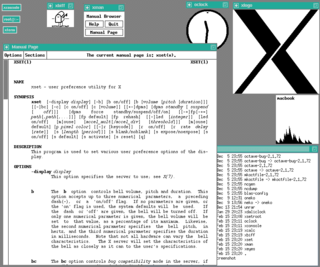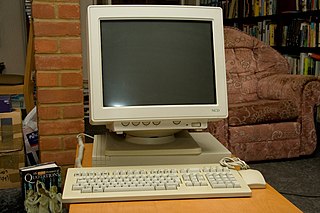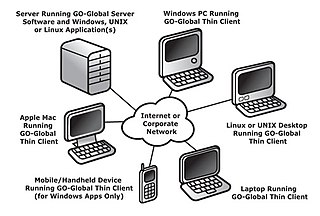This article has multiple issues. Please help improve it or discuss these issues on the talk page . (Learn how and when to remove these template messages) (Learn how and when to remove this template message)
|
In the X Window System, an X display manager is a graphical login manager which starts a session on an X server from the same or another computer.

The X Window System is a windowing system for bitmap displays, common on Unix-like operating systems.
A login manager is a login system for Unix and Unix-like operating systems. It comprises a login daemon, a login user interface, and a system for tracking login sessions. When a user tries to log in, the login manager passes the user's credentials to an authentication system.
In computing, a login session is the period of activity between a user logging in and logging out of a (multi-user) system.
Contents
- Local and remote display management
- X Display Manager Control Protocol
- History
- Some implementations
- Active
- Inactive
- See also
- Sources
- References
- External links

A display manager presents the user with a login screen. A session starts when a user successfully enters a valid combination of username and password.

A password, sometimes called a passcode, is a memorized secret used to confirm the identity of a user. Using the terminology of the NIST Digital Identity Guidelines, the secret is memorized by a party called the claimant while the party verifying the identity of the claimant is called the verifier. When the claimant successfully demonstrates knowledge of the password to the verifier through an established authentication protocol, the verifier is able to infer the claimant’s identity.
When the display manager runs on the user's computer, it starts the X server before presenting the user the login screen, optionally repeating when the user logs out. In this condition, the DM realizes in the X Window System the functionality of getty and login on character-mode terminals. When the display manager runs on a remote computer, it acts like a telnet server, requesting username and password and starting a remote session.
getty, short for "get tty", is a Unix program running on a host computer that manages physical or virtual terminals (TTYs). When it detects a connection, it prompts for a username and runs the 'login' program to authenticate the user.

A computer terminal is an electronic or electromechanical hardware device that is used for entering data into, and displaying or printing data from, a computer or a computing system. The teletype was an example of an early day hardcopy terminal, and predated the use of a computer screen by decades.
Telnet is a protocol used on the Internet or local area network to provide a bidirectional interactive text-oriented communication facility using a virtual terminal connection. User data is interspersed in-band with Telnet control information in an 8-bit byte oriented data connection over the Transmission Control Protocol (TCP).
X11 Release 3 introduced display managers in October 1988 with the aim of supporting the standalone X terminals, just coming onto the market. Various display managers continue in routine use to provide a graphical login prompt on standalone computer workstations running X. X11R4 introduced the X Display Manager Control Protocol (XDMCP) in December 1989 to fix problems in the X11R3 implementation.

In computing, an X terminal is a display/input terminal for X Window System client applications. X terminals enjoyed a period of popularity in the early 1990s when they offered a lower total cost of ownership alternative to a full Unix workstation.







